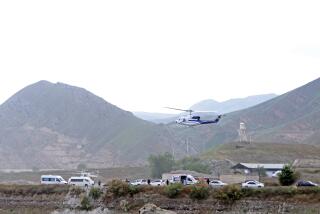NEWS ANALYSIS : Copter Tragedy Tarnishes Luster of Gulf War Success
- Share via
ISTANBUL, Turkey — The American “friendly fire” that shot down two U.S. helicopters over the mountains of Iraqi Kurdistan on Thursday also blew a gaping hole in a fragile success story that has grown out of the 1991 Persian Gulf War.
As the hours of silence lengthened after the midmorning tragedy, reports here strengthened that U.S. pilots had probably killed all four allied colonels--American, British, French and Turkish--who had spearheaded Western efforts to protect the 3.5 million ethnic Kurds of northern Iraq from the armies of the vengeful Iraqi president, Saddam Hussein.
The helicopters carrying the colonels and the other victims crashed north of Salahuddin, an old summer mountain resort. The passengers on the doomed helicopters apparently were due to land in the town for a lavish feast and talks with leaders of the two main Iraqi Kurdish guerrilla groups.
Such meetings are usually a pleasant, monthly routine for the high-powered military mission, which is based in a small house behind a sandbagged perimeter in Zakhu, near the Turkish border in northwestern Iraq. These are the forward elements of Operation Provide Comfort, the successor to allied operations in northern Iraq after the Gulf War.
The operation’s mission is to ensure that Hussein’s army does not advance over front lines with Iraqi Kurdistan and repeat the attacks that drove 1.5 million Iraqi Kurdish refugees into the wintry mountains of Turkey and Iran after the collapse of their post-Gulf War revolt.
To accomplish these goals, the allies’ chief step has been to declare a “no fly” zone north of the 36th Parallel, incorporating most of Iraqi Kurdistan. (Allied planes have been enforcing a similar air umbrella over southern Iraq, south of the 32nd Parallel, to protect Shiite Muslims since August, 1992.)
The allies have been enforcing the “no fly” edict with a force of American, French and British warplanes based in Incirlik, near Adana in Turkey.
An American spokesman at Incirlik declined to say how many U.S. warplanes fly into Iraq, though the number is believed to be between 20 and 30.
U.S. helicopters are based at another Turkish air base in Diyarbakir. Ground support crews make up the bulk of about 1,700 service personnel.
Under this allied protection, the Kurds have made amazing progress, considering the circumstances of the international embargo against Iraq, regional hostility and a harsh blockade from the Baghdad-controlled south.
Hundreds of the thousands of Kurdish villages dynamited by Hussein’s engineers have been rebuilt. Reasonably democratic elections have been held. An autonomous administration is gradually establishing itself--to the extent that it stamps passports and has posted some representatives abroad.
But entry signs saying “Welcome to Kurdistan” also send shivers in neighboring Middle Eastern states such as Turkey, Syria and Iran.
All these countries have restive Kurdish minorities, totaling more than 20 million people; the Kurds commonly are called the world’s largest nation without a state.
Meantime, Iraq has not given up on its Kurdish mountains.
The two main Kurdish groups said in a joint April 12 statement that they had arrested two Iraqi agents with orders to attack the few foreigners still helping or monitoring developments in Iraqi Kurdistan--U.N. guards, workers for aid agencies and foreign journalists.
Under interrogation, the two men were said to have confessed to playing a part in an upsurge in attacks on foreigners in the last month, specifically the murder of German reporter Lissy Schmidt on April 3 and the shooting and injuring of two Austrian U.N. guards on March 27. In a separate incident, a bomb exploded in the car of a Swedish reporter, who was slightly hurt.
On Thursday, Kurdish officials initially expressed their belief that the Iraqis had shot down the U.S. helicopters as part of this campaign.
Besides the smaller-scale efforts that the Kurds say they have detected, other analysts in the region also see signs of increased threatening moves by the Iraqi dictator, who has made clear his unhappiness with the U.N. Security Council’s extension last month of the 3 1/2-year-old trade sanctions that are strangling Iraq.
In recent weeks, analysts say Hussein has strengthened his northern army, which rings the western and southern boundaries of the 19,300-square-mile, allied-protected enclave.
After moving up as many as two divisions of his elite Republican Guard--equipped with battle tanks and helicopter gunships, backed by other armored and mechanized infantry units--Hussein has between 150,000 and 280,000 troops in the north, the Associated Press has said.
These troops are facing 30,000 or so lightly armed Kurdish guerrillas who call themselves peshmerga, or “those who face death.”
Kurdish officials, the AP said, have reported that in recent weeks many of the estimated 3 million people living in the enclave are packing their bags and preparing to flee because they fear that the unpredictable Hussein will move against them once again.
Hussein’s brutal repression against the Kurds has sparked a global outcry. Thousands of Kurds died of starvation and exposure in the northern mountains after Hussein’s forces crushed their rebellion in April, 1991.
More to Read
Sign up for Essential California
The most important California stories and recommendations in your inbox every morning.
You may occasionally receive promotional content from the Los Angeles Times.













